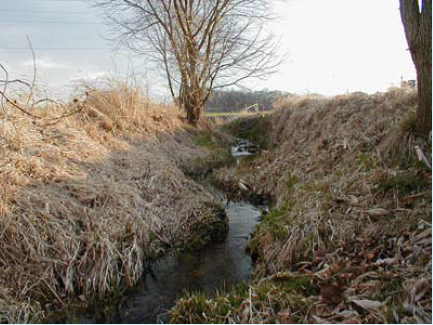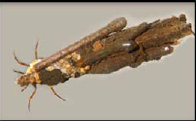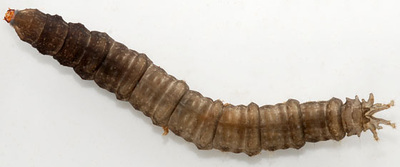|
On December 6th 2013, Professor Bill Lamp updated the Entomology colloquium crowd on one of his ongoing projects looking at the possible non-target effects of transgenic corn on the ecology of agricultural streams. Bt corn is one of the most widely planted transgenic crops in the US, with 88% of all planted corn in 2012 some form of a Bt hybid. Bt corn was developed in order to suppress corn damage done by the European Corn Borer and other caterpillars. Bt corn has one or more genes from the soil-dwelling bacterium, Bacillus thuringiensis. These genes code for “cry” proteins, which are endotoxins that bind to the gut lining of insects and reduce or stop their feeding. While these proteins target insect pests of corn, there is continuing concern that Bt corn and other genetically modified crops may have negative effects on non-target species. It is with this concern, as well as the observations that many corn fields are adjacent to streams, that led Professor Lamp, his collaborators, and his lab to investigate the environmental risk of potential exposure and hazardous effects of Bt corn on stream insects. Headwater streams are ecologically-important ecosystems that are dependent upon allochthonous (externally derived) energy, such as leaf litter. Leaf litter entering the stream is rapidly colonized by fungi and bacteria, which are then fed on by shredder invertebrates. These shredder invertebrates play a key role in stream food weds by breaking down leaves into finer particulate organic matter that becomes food for other, downstream invertebrates. Shredders also serve as prey for predatory insects and fish, thus a loss of shredder invertebrates because of deleterious effects of Bt corn would have negative effects on the stream food web. In 2004-2005 Professor Lamp and his lab investigated the possible effects of Bt corn debris on the decomposition of leaf tissue and its colonization by macroinvertebrates. They placed leaf bags filled with senesced corn debris from 3 near-isoline variety treatments (non-Bt, Cry1Ab only, Cry1Ab+Cry3Bb) into streams and collected them over time. They found that there was no difference among corn debris treatments with regards to decomposition rates or invertebrate colonization.  Corn bag in a stream. (Photo by Bill Lamp) Corn bag in a stream. (Photo by Bill Lamp) Professor Lamp and his lab also tested whether transgenic corn tissue from fields was making its way into streams. In 2006-2007 and again in 2007-2008, they placed cages along the side of streams, as well as in streams, to catch corn debris. Corn debris indeed entered the streams, with a peak input in March. Bioassays tested whether the Cry1Ab protein were still active in the corn tissues at harvest and several weeks after harvest. They found that Cry1Ab protein in corn debris was no longer active after 2 weeks of exposed in both the terrestrial and aquatic environment. Professor Lamp and his lab also looked at the effect of Bt corn debris on four shredder species directly: 2 caddisflies(Pycnopsyche cf. scabripennis, and Lepidostoma sp.), tipulid fly larva (Tipula cf. abdominalis) and a freshwater isopod (Caecidotia communis). They observed no effects on mass, head capsule size or survival of either caddisfly with exposure, however, both the tipulid fly larva and isopod were negatively affected by exposure to the Cry1Ab protein. Surprisingly, no deleterious effects were observed with exposure to the stacked Cry1Ab+Cry3Bb1 corn leaves. The working hypothesis was that differences were mediated via differences in the tissue as they grew in response to Bt treatments and not to the presence of cry proteins per se. To test the effect of Cry1Ab and other toxins independent of plant tissue, Professor Lamp stressed that a tier 1 assay is needed. Dr. Qin Wang, of the Department of Food Safety and Professor Lamp's doctoral student, Ryan Gott, are currently working on a method to test for negative effects of potential toxins by ingestion without any plant tissue effects, by coating food and toxins with a polymer in order to feed them directly to an amphipod, Hyalella azteca.
Responding to the widespread use of newly engineered Bt corn products (e.g., Smartstax and Viptera), in 2011 and 2012 Dr. Lamp and colleagues repeated their debris collection trials with these varieties. In contrast to the earlier trials, corn debris from these varieties had high amounts of Bt bioactivity present at least 28 weeks after harvest. After 4 weeks, leaf bags of Smartstax and Viptera, placed in and alongside of ditches still had active Bt proteins, however colonization and leaf breakdown rates were not significantly different from non Bt corn. As new varieties of Bt corn hit the market and become widely used, it is important for environmental safety. New varieties contain genes encoding for novel proteins and more combinations of proteins. These changes may allow longer residence times and persistence of Bt proteins in corn tissue, which increases the exposure of Bt to non-target species. Further testing is an ongoing process. Background readings: * Jensen et al. Exposure and non-target effects of transgenic Bt corn debris in streams. Environ. Entomol. (2010) * Swan et al. Processing of transgenic crop residues in stream ecosystems. J. Appl. Ecol. (2009) About the Author: Emily Zobel is an MS student in Cerruti Hooks’ Lab. She is currently studying the feeding habits of the invasive brown marmorated stink bug on vegetable crops. |
Categories
All
Archives
June 2024
|
Department of Entomology
University of Maryland
4112 Plant Sciences Building
College Park, MD 20742-4454
USA
Telephone: 301.405.3911
Fax: 301.314.9290
University of Maryland
4112 Plant Sciences Building
College Park, MD 20742-4454
USA
Telephone: 301.405.3911
Fax: 301.314.9290




 RSS Feed
RSS Feed




